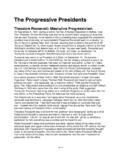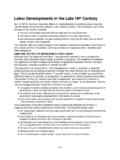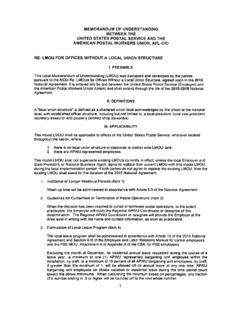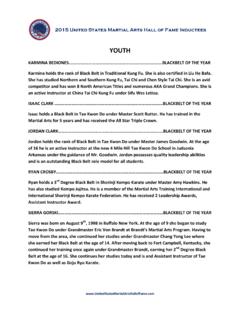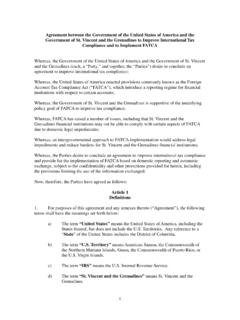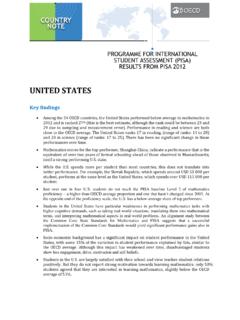Transcription of American Industry (1860-1900)
1 American Industry (1860-1900) by the Industrial of the Civil of Railroads & TelegraphIII. The Rise of Big BusinessIndustrialization by the 1860s In 1860 there were more than 140,000 factories in the United States. About million Americans worked in factories. Still, however, the United States continued to be primarily an agricultural nation. Seventy percent of all Americans were farmers. The great majority of industrial workers in 1860 were women and children. For this reason they had little impact on the political scene. This changed in 1877 when a nationwide strike of railroad workers took place.
2 Americans came to realize that workers had the power to bring America to a standstill. By 1900 million Americans were involved in Industry . In 1980 only about 20 percent of the population even lived in a rural could be argued that the transformation of the United States from a rural, agricultural nation before the Civil War, into an industrialized nation by 1900 is one of the most dramatic changes in history. Before the Civil War, manufacturing in the United States was on a small scale. The United States was about 5th in the world in industrial production.
3 By 1890 the United States had become the leading industrial nation in the world. By 1900 American exports topped $11 billion by 1924, $24 decades after the Civil War shaped the growth patterns of modern American corporations. Some historians have argued that the war did a great deal to retard the growth of Industry , but it cannot be denied that the demand for arms, supplies, transportation and the industrial community. In the decades after the war, America s Industry began to apply the lessons learned in supplying the needs of war to the creation of consumer Industry had an enormous domestic market and labor source.
4 The population of the United States tripled between 1860 and 1910. The nation s 1 of 10population grew from 30 million in 1860 to 90 million in 1910. During the same period urbanization grew as never before. In 1840 only one person out of every nine lived in a city. By 1900 half of all Americans were city European industrial nations had to depend on other nations or far- [lung colonies to be a market for [inished goods or for the raw materials needed to produce [inished goods. This was not necessary for American Industry . In 1860 Americans had only begun to scratch the surface in terms of exploiting our natural resources.]]]
5 From the end of the Civil War to the 1900s, American resources were exploited on an increasingly grander scale. In 1860 the United States mined 15 million tons of coal. In 1900 500 CapitalIn the second half of the 19th century capital became increasingly more available for business and industrial ventures. Foreign investors were attracted to the great growth potential of the American economy. In addition, numerous American banks, grown wealthy on war investments and loans, began to invest money in capitalist ventures. The ready availability of capital attracted entrepreneurs who were capable and creative.
6 Government Support of BusinessBoth the federal and state governments supported American Industry . The United States made enormous land grants to railroad companies to encourage the expansion of rail transportation. About 10 percent of the land in the United States was given to private businesses by federal and state governments in the latter half of the last century. The most important protection, and in the [inal analysis, the most injurious, which the government gave to American Industry was protective tariffs. As we shall see over the course of this year, the tariff became a major political issue in the United States.]
7 Tariffs have been employed by our government to both raise revenue and to protect native factor that increased the industrialization of the United States, was the growth of technology. By 1860 the United Sates patent of[ice had granted 4,000 patents. By 1914 the number had grown to 41,000. Increasingly, the discoveries and principles of science were exploited to produce either industrial goods or consumer goods. Examples of technical innovations which were born in the latter half of the 19th century include the internal combustion engine, the telephone, the phonograph, electricity, refrigeration, the motorized reaper and tractor, the repeating and bolt action ri[le, the machine gun, industrial cigarette rolling machines, the Bessemer steel converter, the typewriter, and on and of 10 The growth of the American labor supply aided Industry .]]
8 In order for Industry to [lourish it is necessary to have cheap labor. This labor was provided from two sources the native population and immigrants from Central and Eastern Europe. Both groups grew enormously during the last third of the 19th last factor, that contributed to the growth of Industry in the United States, is the Revolution in transportation and communication, which was made possible by the railroads and the & TelegraphBetween 1870 and 1900 railway mileage in the United States increased from 53,000 miles to 190,000. During the same years the railroads improved in speed, comfort and safety.]
9 Comfort increased considerably for passengers on long trips with the introduction of the Pullman sleeper car in the 1870s. Single sets of tracks were replaced with a double system over most of the country. This made it possible for rail traf[ic to [low two ways with snarl- up. Iron rails, which tended to shatter under heavy loads, were replaced with steel rails. This allowed trains to carry heavier freight loads. Locomotive tenders were built better so that coal could be burned in them instead of wood. Coal is more ef[icient than wood. This made for fewer fuel stops and more powerful engines.]]]
10 In 1869 Westinghouse patented the air brake. The air brake was a more ef[icient system than mechanical brakes. This made it possible for trains to carry heavier loads other important factors contributed to the growth and success of rail transportation in the United States. As a result of the Kansas- Nebraska Act, most western rail lines stopped in Chicago. As a result that city became the meatpacking center for the United States. Livestock from the western prairie was loaded into railcars and brought east by train. In Chicago the livestock was slaughtered and processed into cans, barrels, and refrigerator cars.]
